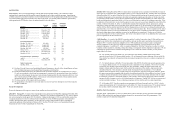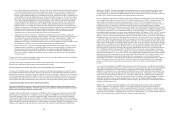Dish Network 2012 Annual Report Download - page 17
Download and view the complete annual report
Please find page 17 of the 2012 Dish Network annual report below. You can navigate through the pages in the report by either clicking on the pages listed below, or by using the keyword search tool below to find specific information within the annual report.22
22
Item 1A. RISK FACTORS
The risks and uncertainties described below are not the only ones facing us. If any of the following events occur,
our business, financial condition or results of operations could be materially and adversely affected.
Competition and Economic Risks Affecting our Business
We face intense and increasing competition from satellite television providers, cable companies and
telecommunications companies, especially as the pay-TV industry has matured, which may require us to increase
subscriber acquisition and retention spending or accept lower subscriber activations and higher subscriber
churn.
Our business is primarily focused on providing pay-TV services and we have traditionally competed against satellite
television providers and cable companies, some of whom have greater financial, marketing and other resources than
we do. Many of these competitors offer video services bundled with broadband, telephony services, HD offerings,
interactive services and video on demand services that consumers may find attractive. Moreover, mergers and
acquisitions, joint ventures and alliances among cable television providers, telecommunications companies and
others may result in, among other things, greater financial leverage and increase the availability of offerings from
providers capable of bundling television, broadband and telephone services in competition with our services. We
and our competitors increasingly must seek to attract a greater proportion of new subscribers from each other’s
existing subscriber bases rather than from first-time purchasers of pay-TV services. In addition, because other pay-
TV providers may be seeking to attract a greater proportion of their new subscribers from our existing subscriber
base, we may be required to increase retention spending.
Competition has intensified in recent years as the pay-TV industry has matured and the growth of fiber-based pay-
TV services offered by telecommunications companies such as Verizon and AT&T continues. These fiber-based
pay-TV services have significantly greater capacity, enabling the telecommunications companies to offer substantial
HD programming content as well as bundled services. This increasingly competitive environment may require us to
increase subscriber acquisition and retention spending or accept lower subscriber activations and higher subscriber
churn. Further, as a result of this increased competitive environment and the maturation of the pay-TV industry,
future growth opportunities of our core pay-TV business may be limited and our margins may be reduced, which
could have a material adverse effect on our business, results of operations, financial condition and cash flow.
Competition from digital media companies that provide or facilitate the delivery of video content via the Internet
may reduce our gross new subscriber activations and may cause our subscribers to purchase fewer services from
us or to cancel our services altogether, resulting in less revenue to us.
Our business is primarily focused on pay-TV services, and we face competition from providers of digital media,
including companies that offer online services distributing movies, television shows and other video programming.
Moreover, new technologies have been, and will likely continue to be, developed that further increase the number of
competitors we face with respect to video services. For example, online platforms that provide for the distribution
and viewing of video programming compete with our pay-TV services. These online platforms may cause our
subscribers to disconnect our services. In addition, even if our subscribers do not disconnect our services, they may
purchase a certain portion of the services that they would have historically purchased from us through these online
platforms, such as pay per view movies, resulting in less revenue to us. Some of these companies have greater
financial, marketing and other resources than we do. In particular, programming offered over the Internet has
become more prevalent as the speed and quality of broadband and wireless networks have improved. In addition,
consumers are spending an increasing amount of time accessing video content via the Internet on their mobile
devices. These technological advancements and changes in consumer behavior with regard to the means by which
they obtain video content could reduce our gross new subscriber activations and could materially adversely affect
our business, results of operations and financial condition or otherwise disrupt our business.
23
23
Sustained economic weakness, including continued high unemployment and reduced consumer spending, may
adversely affect our ability to grow or maintain our business.
A substantial majority of our revenue comes from residential customers whose spending patterns may be affected by
sustained economic weakness and uncertainty. Economic weakness and uncertainty persisted during 2012. Our
ability to grow or maintain our business may be adversely affected by sustained economic weakness and uncertainty,
including the effect of wavering consumer confidence, continued high unemployment and other factors that may
adversely affect the pay-TV industry. In particular, economic weakness and uncertainty could result in the
following:
x Fewer gross new subscriber activations and increased subscriber churn. We could face fewer gross new
subscriber activations and increased subscriber churn due to, among other things: (i) the sustained weak
housing market in the United States combined with lower discretionary spending; (ii) increased price
competition for our products and services; and (iii) the potential loss of retailers, who generate a significant
portion of our new subscribers, because many of them are small businesses that are more susceptible to the
negative effects of economic weakness. In particular, subscriber churn may increase with respect to
subscribers who purchase our lower tier programming packages and who may be more sensitive to
sustained economic weakness, including, among others, our pay-in-advance subscribers.
x Lower pay-TV average monthly revenue per subscriber (“Pay-TV ARPU”). Our Pay-TV ARPU could be
negatively impacted by aggressive introductory offers by our competitors and the growth of video content
being delivered via the Internet. Furthermore, due to lower levels of disposable income, our customers may
downgrade to lower cost programming packages, elect not to purchase premium services or pay per view
movies or may disconnect our services and choose to replace them with less expensive alternatives such as
video content delivered via the Internet, including, among others, video on demand.
x Higher subscriber acquisition and retention costs. Our profits may be adversely affected by increased
subscriber acquisition and retention costs necessary to attract and retain subscribers during a period of
economic weakness.
Our competitors may be able to leverage their relationships with programmers to reduce their programming costs
and offer exclusive content that will place them at a competitive advantage to us.
The cost of programming represents the largest percentage of our overall costs. Certain of our competitors own
directly or are affiliated with companies that own programming content that may enable them to obtain lower
programming costs or offer exclusive programming that may be attractive to prospective subscribers. Unlike our
larger cable and satellite competitors, we have not made significant investments in programming providers. For
example, Comcast and General Electric have joined their programming properties, including NBC, Bravo and many
others that are available in the majority of our programming packages, in a venture, NBCUniversal, controlled by
Comcast. This transaction may affect us adversely by, among other things, making it more difficult for us to obtain
access to their programming networks on nondiscriminatory and fair terms, or at all. The transaction was approved
by the FCC and the Department of Justice in January 2011. The FCC conditioned its approval on, among other
things, Comcast complying with the terms of the FCC’s recent order on network neutrality, even if that order is
vacated by judicial or legislative action, and Comcast licensing its affiliated content to us, other traditional pay-TV
providers and certain providers of video services over the Internet on fair and nondiscriminatory terms and
conditions, including, among others, price. If Comcast does not license its affiliated content to us on fair and
nondiscriminatory terms and conditions, we can seek binding arbitration and continue to carry such content while
the arbitration is pending. However, it is uncertain how these conditions may be interpreted and enforced by the
FCC; therefore, we cannot predict the practical effect of these conditions.
























